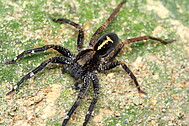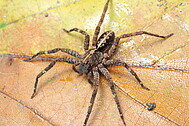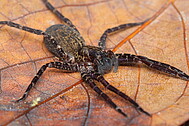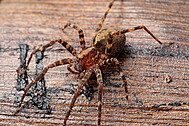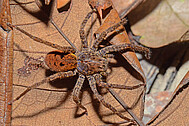Natural history of Ctenus in Amazonian forests
Although the spiders of the genus Ctenus are potential prey of larger spiders, such as Phoneutria spp., they dominate the ground stratum in most of the forests by number. There is evidence that juvenile spiders of the genus Phoneutria smaller than adult Ctenus spp. avoid the ground stratum due to the risk to be predated by them. Only in swamp forests the predominance of Ctenus on the ground is assumed by one of the largest wandering spiders species – Ancylometes rufus.
The life of a Ctenus spider is not easy. It is smaller than Phoneutria and Ancylometes as adult, which means a lower number of eggs and the high-risk of encounter with other adults of the same genus or even bigger spiders. Ctenus lose to all other ctenid spiders in terms of survival. They do not use burrows to hide nor have the ability to dive in water or to jump from a leaf to escape from a predator. Its camouflage is also not the most perfect in the family. Its only concession to security seems to be the restriction of its activity to nighttime, which releases the top-down pressure by many lizards and birds. They live in the most dangerous place in the woods for animals of their size due to the high abundance of predators, among which the worst are army ants and other Ctenus. Some army ant species hunt in swarms of thousands of individuals covering large areas of the ground and are so devastating that few arthropods survive their raid. Spiders are fortunate when they reach a tree trunk fast enough to escape by climbing upwards. However, the frequency of army ant raids is so high in dense forests, that few spiders reach adulthood, having escaped at least once a raiding swarm (Vieira & Höfer 1994, 1998). And still - they are among the most successful wandering spiders of the forest.
The reason for success in nature is never just one. One of the most important may be the ability to detect chemical marks of prey. We do not know how much Ctenus spiders are better than other ctenids, but our own experiments (Portela - unpublished dissertation 2013 [Portela et al. 2013]) showed that they can efficiently detect the tracks of some of the potential prey. Therefore, at least in this aspect, the name “tropical wolf spider” is appropriate. Another important feature is the ability to adhere to the slippery leaves of the higher vegetation. Although they do not have the same agility as Phoneutria in vegetation [Lapinski & Tschapka 2013], this ability may help to escape from army ants and to seek for safety in small plants while consuming their prey. It is also important for fast movements on the leaf litter on the ground to escape from predators or to capture prey. Although the number of eggs is not as great as for the larger species, the time necessary to become adult is certainly much shorter, which may compensate for the lower number of eggs. While Phoneutria takes three years to produce an egg-sac with an offspring of more than 500 spiderlings, Ctenus could have 3-6 generations in this period, with a potential for a comparably large offspring, although with only about 80 eggs per generation. Of course it is not only a simple multiplication, since the survival rate is low, but the speed of recovery of populations after periods of low abundance shows that the reproduction is very efficient.
There are five species of Ctenus co-occurring in forests of the Manaus region. Four of them fit the description above. One species – Ctenus inaja, lives above the ground in trees and has an ecology so different that we have doubts if it really belongs to the genus Ctenus (reconsiderations of positions of species in genera are common in zoology). The other four show strong size differences C. villasboasi is the largest, C. manauara is the smallest and the other two, C. crulsi and C. amphora have similar sizes in between. It is not yet clear in detail why the coexistence of these four species is possible; however, we found an important unforeseen factor: the difference in the ability to capture a special type of prey, i.e. termites of the genus Syntermes. These termites are large and abundant consumers of leaf-litter and live in underground nests. When they come to the surface to cut the leaves, they become interesting prey for the spiders. The problem is that the appetizing workers are defended by aggressive soldiers. We found that C. crulsi consumed these termites more frequently than C. amphora of similar size, and that this is due to a greater ability to capture them. As termites are more common in clay soils, C. crulsi becomes more abundant in areas with this type of soil and avoids the sandy soils. Once C. amphora consumes only few of these termites, they had disadvantage on clayey soils, but find regions of sandy soil almost free of other Ctenus to live and reproduce. Our studies have already shown that C. crulsi but not C. amphora prefer clayey soil to sandy soil (Gasnier & Höfer 2001).


